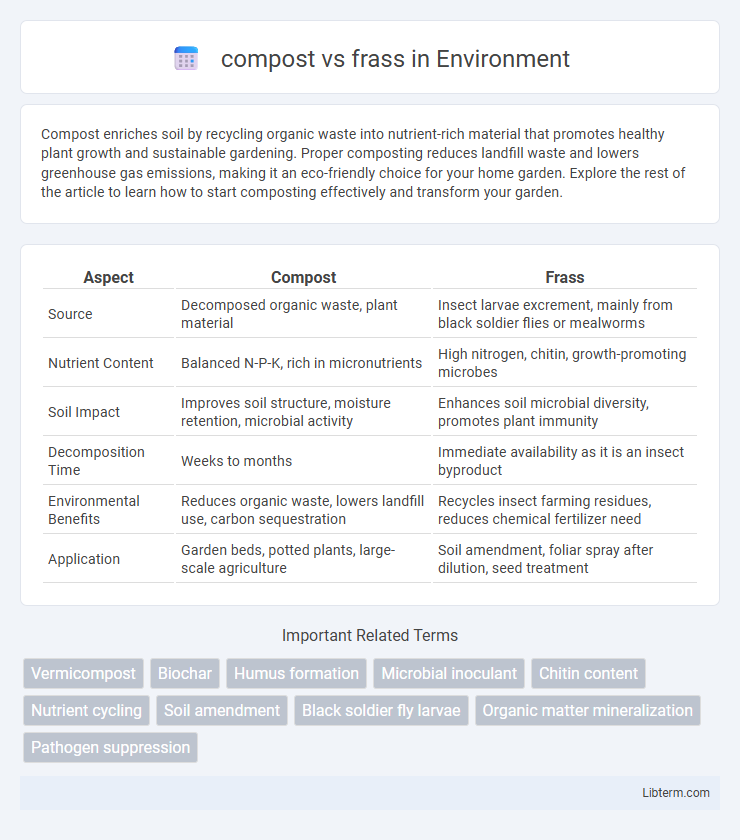Compost enriches soil by recycling organic waste into nutrient-rich material that promotes healthy plant growth and sustainable gardening. Proper composting reduces landfill waste and lowers greenhouse gas emissions, making it an eco-friendly choice for your home garden. Explore the rest of the article to learn how to start composting effectively and transform your garden.
Table of Comparison
| Aspect | Compost | Frass |
|---|---|---|
| Source | Decomposed organic waste, plant material | Insect larvae excrement, mainly from black soldier flies or mealworms |
| Nutrient Content | Balanced N-P-K, rich in micronutrients | High nitrogen, chitin, growth-promoting microbes |
| Soil Impact | Improves soil structure, moisture retention, microbial activity | Enhances soil microbial diversity, promotes plant immunity |
| Decomposition Time | Weeks to months | Immediate availability as it is an insect byproduct |
| Environmental Benefits | Reduces organic waste, lowers landfill use, carbon sequestration | Recycles insect farming residues, reduces chemical fertilizer need |
| Application | Garden beds, potted plants, large-scale agriculture | Soil amendment, foliar spray after dilution, seed treatment |
Understanding Compost and Frass: Key Differences
Compost is a nutrient-rich organic material produced through the aerobic decomposition of plant and food waste, essential for improving soil structure and fertility. Frass, by contrast, is insect excrement, mainly from larvae like black soldier flies or mealworms, containing concentrated nutrients and beneficial microbes that enhance plant growth and pest resistance. While compost provides broad soil enrichment, frass offers targeted nutrient delivery and microbial benefits, making both valuable but distinct soil amendments.
What Is Compost? Origins and Composition
Compost is an organic matter-rich substance created through the controlled decomposition of plant materials, food scraps, and garden waste by microorganisms. Originating from ancient agricultural practices, compost composition typically includes carbon-rich "browns" such as leaves and straw, and nitrogen-rich "greens" like grass clippings and kitchen scraps, balanced to optimize microbial activity. This nutrient-dense material enhances soil structure, water retention, and microbial diversity, supporting sustainable plant growth.
What Is Insect Frass? Defined and Explained
Insect frass, composed of insect excrement, shed exoskeletons, and undigested organic matter, serves as a nutrient-rich organic fertilizer and soil conditioner. Unlike traditional compost, which decomposes plant and food waste through microbial activity, frass contains chitin and beneficial microbes that enhance soil health and stimulate plant growth. Its concentrated nutrients, including nitrogen, phosphorus, and potassium, provide targeted nourishment that improves plant immune responses and promotes sustainable agriculture.
Nutrient Profiles: Compost vs Frass
Compost typically contains a balanced nutrient profile with moderate levels of nitrogen, phosphorus, and potassium, as well as a variety of micronutrients beneficial for soil health. Frass, derived from insect excrement, often has higher concentrations of nitrogen and chitin, which can enhance microbial activity and improve plant immune responses. While compost improves soil structure and nutrient retention over time, frass acts as a potent organic fertilizer promoting immediate nutrient availability and pest resistance.
Soil Health Benefits: Comparing Effects
Compost enriches soil by adding organic matter, improving nutrient content, and enhancing soil structure for better water retention and aeration. Frass, a nutrient-rich insect excrement, acts as a natural fertilizer boosting microbial activity and providing essential micronutrients for soil vitality. Both improve soil health but compost primarily builds long-term organic matter while frass delivers immediate nutrient availability and promotes beneficial soil microorganisms.
Application Methods for Compost and Frass
Compost is typically applied by spreading it evenly across soil surfaces or incorporating it into garden beds and fields to enhance soil fertility and structure. Frass, a byproduct of insect larvae digestion, is usually delivered as a foliar spray or diluted in water for root drenching to provide targeted nutrient uptake and pest resistance. Both application methods maximize nutrient availability but differ in delivery speed and specific crop benefits.
Environmental Impact Analysis
Compost and frass differ significantly in environmental impact; compost reduces organic waste by transforming food scraps and yard waste into nutrient-rich soil amendments, enhancing soil health and carbon sequestration. Frass, a byproduct of insect farming, provides a sustainable fertilizer alternative that lowers reliance on synthetic chemicals, minimizes greenhouse gas emissions, and supports circular agriculture. Life cycle analyses show frass production requires less land and water compared to traditional composting, further reducing its ecological footprint.
Cost and Accessibility of Compost and Frass
Compost generally offers a more affordable and widely accessible option for gardeners and farmers, as it can be produced from various organic waste materials locally. Frass, the excrement of insect larvae like black soldier flies, tends to be more expensive due to specialized production and limited commercial availability. While compost is easily sourced through community programs or home production, frass often requires purchase from niche suppliers, impacting its accessibility for large-scale use.
Best Use Cases: When to Choose Compost or Frass
Compost is ideal for enriching garden soil by improving texture, moisture retention, and microbial activity, making it perfect for vegetable beds, flower gardens, and lawn applications. Frass, derived from insect excrement, excels as a natural fertilizer rich in chitin and nitrogen, promoting plant immunity and stimulating growth, particularly beneficial for seedlings, potted plants, and high-value crops. Selecting compost is best for broad soil amendment and organic matter enhancement, while frass suits targeted nutrient delivery and pest resistance in sensitive and high-yielding plants.
Future Trends in Organic Soil Amendments
Future trends in organic soil amendments highlight the growing preference for frass due to its high nutrient density and microbial diversity, enhancing soil health and plant growth more rapidly than traditional compost. Innovations in insect farming are driving sustainable frass production, positioning it as a scalable alternative to compost that reduces waste and supports circular agriculture. Research emphasizes integrating frass with compost to balance immediate nutrient availability and long-term soil organic matter improvement.
compost Infographic

 libterm.com
libterm.com